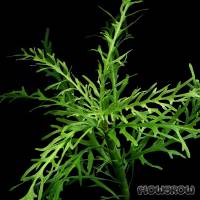



This plant got known under the names Hygrophila sp. 'Guinea' and H. sp. 'Afrika' in the aquarium hobby, and in 2009, Kai Vollesen (Kew, England) identified it as Hygrophila odora.
H. odora is distributed in Western Africa. This bog plant grows to over 50 cm in height and is found, amongst others, on riverbanks. Its emersed form has strong, ascending to upright stems that lignify at the basis, and lanceolate leaves. It has dense short sticky glandular hairs all over and an intensive smell. The light blue to purple flowers are rather large (over 2 cm long) and sit in the upper leaf axils.
The submersed form differs a lot from the terrestrial form, it has no hairs at all and develops light green narrow pinnatisect leaves and relatively hard, thick stems. The lobes or rather, pinna, of the leaves are also lobed in well-developed plants, which makes them look a bit like those of Hygrophila difformis. However, they differ from them by their narrower form, which reminds a little of the narrow but very differently coloured leaves of H. pinnatifida.
In Africa there may be many Hygrophila species, however, in aquaristics, Hygrophila odora is the first and hitherto the only hygro species endemic in Africa. It is very decorative, but - according to experiences to date - a rather demanding aquarium plant, which grows best in soft water, under strong lighting, with an ample supply of macro- and micronutrients (a substrate fertilisation may be necessary) and CO2 injection. According to Hans-Georg Kramer (2009), the plant might be susceptible against a lack of phosphates. A PO4 concentration of the water not under 0.3 mg/l is thus recommendable. High temperatures of over 26 °C seem to be beneficial to the overall development of H. odora (information by Stephan Moenninghoff). Its growth rate depends on the conditions and can be slow to moderately fast.
As other stem plants, H. odora can be propagated by top and lateral cuttings, which may be rather short. Propagation can be furthered by letting the stems float under the surface for a few weeks, which induces them to form many lateral shoots that in turn can be cut off and re-planted.
The emersed form of H. odorata is easier in cultivation than the submersed one, given that it grows in a nutrient-rich substrate, however, as it grows very high it needs a lot of space. The elevated growth rate of the emersed form might be used for more productive propagation. Moreover, emersed cultivation is also worth the while as the purple flowers are really beautiful. However, the plant's intensive smell that reminds somewhat of a male goat, which it effuses when touched, may not be everyone's cup of tea. The thick emersed stems can be rather brittle.
(Last modified: 19.01.2012)
<a href="https://www.flowgrow.de/db/aquaticplants/hygrophila-odora" target="_blank"><img alt="Hygrophila odora" title="Hygrophila odora" src="https://www.flowgrow.de/db/widget/aquaticplants/hygrophila-odora" /></a>
[url=https://www.flowgrow.de/db/aquaticplants/hygrophila-odora][img]https://www.flowgrow.de/db/widget/aquaticplants/hygrophila-odora[/img][/url]
[widget=aquaticplants/hygrophila-odora]Hygrophila odora[/widget]